|
|
|
Sort Order |
|
|
|
Items / Page
|
|
|
|
|
|
|
| Srl | Item |
| 1 |
ID:
166970
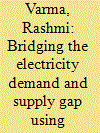

|
|
|
|
|
| Summary/Abstract |
Efficient and reliable electricity supply is critical for economic growth. India is facing multiple challenges of meeting country's electricity requirement, finding suitable resource transition from depleting fossil fuels and addressing the concern of climate change.
|
|
|
|
|
|
|
|
|
|
|
|
|
|
|
|
| 2 |
ID:
111415


|
|
|
|
|
| Publication |
2012.
|
| Summary/Abstract |
The growing concerns of global warming and climate change have forced water providers to scrutinize the energy for water production and the greenhouse gas (GHG) emissions associated with it. A system dynamics model is developed to estimate the energy requirements to move water from the water source to the distribution laterals of the Las Vegas Valley and to analyze the carbon footprint associated with it. The results show that at present nearly 0.85 million megawatt hours per year (MWh/y) energy is required for conveyance of water in distribution laterals of the Valley from Lake Mead resulting in approximately 0.53 million metric tons of CO2 emissions per year. Considering the current mix of fuel source, the energy and CO2 emissions will increase to 1.34 million MWh/y and 0.84 million metric tons per year, respectively, by the year 2035. Various scenarios including change in population growth rate, water conservation, increase in water reuse, change in the Lake level, change in fuel sources, change in emission rates, and combination of multiple scenarios are analyzed to study their impact on energy requirements and associated CO2 emissions.
|
|
|
|
|
|
|
|
|
|
|
|
|
|
|
|
| 3 |
ID:
166719
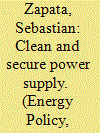

|
|
|
|
|
| Summary/Abstract |
Across the world, the electricity industry is changing with the advent of renewable energy sources such as solar and wind power. As these are exposed to intermittency, seasonality, and global-climate-variation, policy-makers' concerns are now shifting towards security of supply. In fact, the industry confronts three conflicting goals: security of supply, competitive prices to customers, and environmental protection. In this context, and given the multiple uncertainties of technology transformation, this paper uses modelling-based scenario analysis to investigate different extreme and plausible futures. Simulation is used to analyse policies aimed at increasing the penetration of renewables and to explore how these energy sources may affect system reliability. This paper explores the effect of incorporating renewables in Colombia, where a large hydroelectric component has led to insufficient electricity being available during droughts and to high electricity price volatility. Though not intuitive at first glance, this paper shows that renewables may contribute to: i) increased security of supply through complementarity, e.g., it does not rain when the sun shines; ii) reduced price volatility in the medium-term, and iii) increased industry sustainability.
|
|
|
|
|
|
|
|
|
|
|
|
|
|
|
|
| 4 |
ID:
088261


|
|
|
|
|
| Publication |
2009.
|
| Summary/Abstract |
The climatic change is a matter of grave concern to the whole world. As a countermeasure against the climatic change convention, the Korean government has authorized the sale of diesel passenger cars since 2005. In this paper, we analyze the effects of the sales authorization of diesel passenger cars in its role as a countermeasure. Their share, carbon emissions, and pollutant emissions of each type of passenger car are analyzed using system dynamics. The result is that the carbon emissions are decreased by 5.4% but the pollutant emissions are increased by 5%. If the pollutant emissions are controlled, the sales authorization of diesel passenger cars would be a good countermeasure against the climatic change convention.
|
|
|
|
|
|
|
|
|
|
|
|
|
|
|
|
| 5 |
ID:
176852


|
|
|
|
|
| Summary/Abstract |
Renewable Portfolio Standards (RPS) is a mandatory institutional change to realize the low-carbon transformation of energy in China. The success of its implementation depends on the scientific system design. Based on the current situation of the green certificate transaction with the severe shortage of tradable green certificate (TGC) subscription on the demand side of RPS in China and the actual economic situation of the electricity market reform, this paper uses system dynamics to build the market transaction models of benchmark on-grid price and marketed on-grid price respectively, and analyze the incentive effect of the relevant system design of RPS on the demand side of TGC. The results show that: (1) Implementing the marketed on-grid price can effectively stimulate and induce coal power plants to conduct green certificate trading. Compared with benchmark on-grid price, under marketed on-grid price, coal power plants have higher demand for TGC, higher revenue and profit, and better incentive effect. (2)Setting a scientific and reasonable price cap of TGC can effectively stimulate coal power plants to increase the consumption demand of TGC. Therefore, scientific design of the demand-side incentive system of RPS and strengthening of the power market reform will help China to implement the RPS and promote the consumption and utilization of renewable energy.
|
|
|
|
|
|
|
|
|
|
|
|
|
|
|
|
| 6 |
ID:
128021


|
|
|
|
|
| Publication |
2014.
|
| Summary/Abstract |
Fighter aircraft development is difficult and high-risk and only few countries have
the ability to develop their own. Taiwan, as a latecomer, has been successful in
the development of a high-performance fighter. This paper illustrates the Taiwan
experience by the method of system dynamics. The results of this study show that
such development by latecomers has the following characteristics: (1) The government
has a strong commitment to the development due to serious external threats; (2) at least
a firstcomer must exist to provide the necessary key technologies; (3) development
requires the long-term accumulation of manpower and technology. This study also
uses the method of the casual feedback loop to interpret and discuss the development
of other latecomers.
|
|
|
|
|
|
|
|
|
|
|
|
|
|
|
|
| 7 |
ID:
121284


|
|
|
|
|
| Publication |
2013.
|
| Summary/Abstract |
This paper develops a system dynamics model to analyze the impacts of different kinds of capacity payment as investment incentive mechanisms in Iranian electricity market. Since it is aimed that the incurred capital and operating costs of generation technologies be recovered in Iranian electricity pool, the noncompetitive capacity payment mechanism has been introduced for this purpose in order to encourage new investments in electric power generation system. In the current mechanism, the capacity payments are designated to the generating units in the whole country electricity market. An annual base value of capacity payment is proposed based on recovering the capital cost of a benchmark generation technology. This value is altered according to the operational reserve in the day-ahead electricity market. This supporting policy is simulated and analyzed in the proposed dynamic framework in order to track the trend of new investments in the Iranian electricity market. The feasibility study of implementing the regional capacity assignment is the main focus of this paper. Different possible regulating policies such as floating rates for capacity payment and electricity price cap, the multiple capacity payments to various technologies, and the regional electricity market with territorial capacity allocation are examined in order to investigate the consequences and performances of different decisions and policies in the capacity investment of Iranian electricity market.
|
|
|
|
|
|
|
|
|
|
|
|
|
|
|
|
| 8 |
ID:
176118


|
|
|
|
|
| Summary/Abstract |
The petrochemical industry plays a pivotal role in achieving high value-added products from oil and gas reserves. With attention to oil and gas reserves in Iran, it is clear that the petrochemical industry has not grown up adequately. This study aims to determine effective factors on petrochemical industry development and model the mechanism of capacity expansion budget creation using a system dynamics approach. A quantified system dynamics model has been built based on causal relationships and the mechanism of development budget allocation among categorized products. This structure is used to simulate the model and investigate essential variables related to each product, such as production capacity value, production rate, domestic sale revenue, and export. According to the results of a simulation, in 2025, Iran will have a capacity of approximately 104 million tons of petrochemical products that is not desirable. In this study, a policy of improving budget plan and allocation is introduced as the most effective solution to achieve the petrochemical industry development. By implementing this policy the production capacity and total revenue would respectively be improved by 4% and 13% in 2025 in comparison with the base run.
|
|
|
|
|
|
|
|
|
|
|
|
|
|
|
|
| 9 |
ID:
162956


|
|
|
|
|
| Summary/Abstract |
To study the effect of the air pollution charging fee (APCF) policy on the haze pollution in China, a dynamics management model is constructed with the approach of system dynamics and implemented by using the Vensim software. This model is used to simulate and assess the effect of APCF policy on the traffic and the emissions (particularly carbon monoxide (CO), hydrocarbons (HC), nitrogen oxides (NOx), and particulate matter (PM)) in Beijing during the years 2011–2025 in different scenarios. The validity and the robustness of the model are verified by a model test and validation, and a reasonable range of APCF is determined by using a sensitivity analysis. The simulation results showed that the APCF policy effectively realized the “win-win” scenario of emission reduction and congestion release. In particular, the simulation results also indicated some policy effects such as rebound effect (from low-APCF policy), inflection-point effect (from high-APCF policy), and marginal decreasing effect (between moderate and high-APCF policy). These results provide some valid policy recommendations for energy management and emission reduction.
|
|
|
|
|
|
|
|
|
|
|
|
|
|
|
|
| 10 |
ID:
107504


|
|
|
|
|
| Publication |
2011.
|
| Summary/Abstract |
Upon the implementation of the floating price mechanism, Taiwan's gasoline and diesel prices returned to market mechanism, which terminated the phenomenon of the public paying for the losses of the state-owned oil company-Chinese Petroleum Corporation, Taiwan (CPC). Furthermore, the relatively low production costs of the privately owned Formosa Petrochemical Corporation (FPCC) disclosed the pricing mechanism of CPC, which inspired FPCC to adopt pricing strategy in order to increase the market share. This study aims to establish a system dynamics model to analyze the effects of the floating price mechanism on Taiwan's gasoline and diesel markets. This Model is divided into four sub-systems. The model of this study passed several validation tests, and hence, is able to provide a "virtual laboratory" for policy-makers to conduct simulation and scenario analysis. The simulation results indicate (a) feedback mechanism of expected revenues and pricing strategy could efficiently simulate the FPCC pricing mechanism, (b) price competition strategy could increase FPCC revenues, although the effect on market share is not remarkable, and (c) FPCC has a higher gas-station growth rate. Scenario analyses found (a) lowering oil security stockpile would not change FPCC's pricing strategy and (b) FPCC prefers to follow CPC pricing when it has more gas stations.
|
|
|
|
|
|
|
|
|
|
|
|
|
|
|
|
| 11 |
ID:
186411
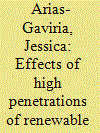

|
|
|
|
|
| Summary/Abstract |
Long-term capacity cycles in electricity markets are a challenge to policy makers, bringing instability in energy prices, and jeopardizing security of supply. There is evidence of capacity cycles in electricity markets using conventional technologies from empirical data, experimental work and simulation studies. In this article we study the effects of the availability of new technologies on the investment cycles observed, using economic experiments performed in a laboratory setting. We consider the decision making process with a new technology that has shorter construction delays, shorter lifetime and an alternative cost structure, compared to the conventional technologies previously studied. Our experimental design follows the current trends to de-carbonize electricity production by introducing variable renewable energy sources (VRES) as part of the generation portfolio. We find that the introduction of VRES does not dampen the capacity oscillations observed. In fact, the shorter delays in construction and technology lifetimes create shorter, more frequent cycles. We provide recommendations to manage the increased cyclical nature in the transition to a low carbon economy.
|
|
|
|
|
|
|
|
|
|
|
|
|
|
|
|
| 12 |
ID:
150870


|
|
|
|
|
| Summary/Abstract |
Following liberalization reforms, the ability of power markets to provide satisfactory incentives for capacity investments has become a major concern. In particular, current energy markets can exhibit a phenomenon of investment cycles, which generate phases of under and over-capacity, and hence additional costs and risks for generation adequacy. To cope with these issues, new mechanisms, called capacity remuneration mechanisms (CRM), have been (or will be) implemented. This paper assesses the dynamic effects of two CRMs, the capacity market and the strategic reserve mechanism, and studies to what extent they can reduce the investment cycles. Generation costs and shortage costs of both mechanisms are also compared to conclude on their effectivity and economic efficiency. A simulation model, based on system dynamics, is developed to study the functioning of both CRMs and the related investment decisions. The results highlight the benefits of deploying CRMs to solve the adequacy issue: shortages are strongly reduced compared to an energy-only market. Besides, the capacity market appears to be more beneficial, since it experiences fewer shortages and generation costs are lower. These comparisons can be used by policy makers (in particular in Europe, where these two CRMs are mainly debated) to determine which CRM to adopt.
|
|
|
|
|
|
|
|
|
|
|
|
|
|
|
|
| 13 |
ID:
118825


|
|
|
|
|
| Publication |
2013.
|
| Summary/Abstract |
An energy security management model using quality function deployment (QFD) and system dynamics (SD) is suggested for application in public policymaking in developing economies. Through QFD, experts are guided toward identifying key energy security components, including indicators and policies, and in making these components consistent, focused, and customized for a particular country. Using these components as inputs, we construct an intermediate complex system dynamics model with a minimal number of crucial interactions. Key policies are simulated and evaluated in terms of the improvement of key indicators. Even with little data, our approach provides a coherent, useful, and customized energy security management model to help policymakers more effectively manage national energy security. To demonstrate its advantages, the model is applied to the Korean gas sector as an example.
|
|
|
|
|
|
|
|
|
|
|
|
|
|
|
|
| 14 |
ID:
186452
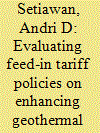

|
|
|
|
|
| Summary/Abstract |
Geothermal is vital for sustainably meeting Indonesia's energy demand, given its estimated massive reserves potential equivalent to 24 GW of electricity. The Indonesian government has set geothermal contributions to the national energy mix at 7,241.5 MW by 2025 and 17,546 MW by 2050, despite harnessing such vast potential needing significant investment. To that goal, the government established a feed-in tariff (FIT) mechanism to encourage private sector investment in geothermal development. However, FIT has undergone significant alterations in a short period. Moreover, various complicating factors—bureaucracy, social, and technical—exist alongside FIT implementation. Therefore, the extent that FIT can effectively enhance geothermal development in Indonesia should be challenged with further investigation. This study explores the efficacy of FIT policies for geothermal electricity by comparing the performance of several FIT schemes in terms of their impact on the government's target achievement. This study combines the policy analysis framework with system dynamics modeling to understand the dynamic interaction of FIT policy and other important components in geothermal development. The findings show that modest bureaucracy and public support are required. Furthermore, to enhance geothermal development more effectively, FIT should be at least 11 cents US$/kWh and accompanied by technical breakthroughs and government-funded exploration activities.
|
|
|
|
|
|
|
|
|
|
|
|
|
|
|
|
| 15 |
ID:
113462


|
|
|
|
|
| Publication |
2012.
|
| Summary/Abstract |
Conserving energy and reducing carbon emissions have become the common responsibility of the international community. During the year 2010, the Taiwan government planned a four-year project budgeted at 300 million US dollars, called "The Penghu Low Carbon Island Development Project." The policy objective is to use Penghu Island (population 85,000) as a test platform to evaluate new ways to conserve energy and reduce carbon emissions before attempting to replicate the policies on Taiwan Island. For Taiwan, a zero carbon island green transportation policy will regulate the total number of electric scooters, the total number of gasoline motorcycles, influence government subsidy incentives, and create the need for new motorcycle license issuing and control. These factors interact with each other to form a complex and dynamic system that impacts policy as well as the current way of life. In this study, a system dynamics approach is designed to construct a model for evaluating the green transportation policy on Penghu Island. Simulations are conducted to model green transportation system behavior and related policy effects in a smaller, controlled environment before creating policies for Taiwan Island that will impact the lives of over 23 million people.
|
|
|
|
|
|
|
|
|
|
|
|
|
|
|
|
| 16 |
ID:
176776


|
|
|
|
|
| Summary/Abstract |
This paper aims to explore the appropriate investment strategy for Chinese power enterprises with the effect of the nationwide carbon emissions trading (NCET) market. Based on the system dynamics (SD) theory and the analysis of investment strategies, the SD model for the investment analysis of power enterprises is proposed. The simulation experiments based on three different investment policy scenarios (i.e., conservative, neutral and active) are conducted. According to the simulation results, the reasonable short-term investment for enterprises should be increased. If enterprises choose to invest more resources in the installation of green powers (hydropower, wind power and photovoltaic), their carbon emissions and profits may be more difficult to achieve qualitative changes in the short term. It is suggested that before the establishment of NCET market, enterprises should give priority to investing in clean technology instead of large-scale green energy installation. In the long run, increasing the investment of green power generation will help enterprises resist the rising cost of carbon trading. In addition, even in the conservative policy environment, the enterprise can still achieve its carbon discharges peak value before 2030, so the government may consider adopting a loose policy standard to support the economic interests of power enterprises.
|
|
|
|
|
|
|
|
|
|
|
|
|
|
|
|
| 17 |
ID:
124576


|
|
|
|
|
| Publication |
2013.
|
| Summary/Abstract |
Electric power industry has a huge carbon mitigation potential, fundamentally because there are large carbon-free, renewable resource options. In Turkey, with growing demand in electricity consumption and incentives offered for natural gas fired electricity generation, CO2 emissions sourced from electric power industry had tripled over the last two decades. Current governmental strategy focuses on energy security and resource diversity in a growing economy and does not articulate sufficient mitigation targets and appropriate regulations. In this research, an original dynamic simulation model is built, validated and analyzed to explore the options for carbon mitigation in Turkish electric power industry. Model structure represents the investment, dispatch and pricing heuristics as well as the natural resource base of electricity generation in Turkey. It operates on annual basis over 30 years to simulate installed capacities and generations of power plants with alternative resources and their resulting CO2 emissions. The analysis presented in this paper reveals that there are mitigation options below 50% of business as usual growth, with common policy options such as feed-in-tariffs, investment subsidies and carbon taxes. The model can serve as an experimental platform for further analysis of problems related to carbon mitigation in Turkish electricity sector.
|
|
|
|
|
|
|
|
|
|
|
|
|
|
|
|
| 18 |
ID:
150896


|
|
|
|
|
| Summary/Abstract |
Liberalisation and the ever larger share of variable renewable energies (VRES), e.g. photovoltaic (PV) and wind energy, affect security of supply (SoS). We develop a system dynamics model to analyse the impact of VRES on the investment decision process and to understand how SoS is affected. We focus on the Swiss electricity market, which is currently undergoing a liberalisation process, and simultaneously faces the encouragement of VRES and a nuclear phase out. Our results show that nuclear production is replaced mainly by PV and imports; the country becomes a net importer. This evolution points to a problem of capacity adequacy. The resulting price rise, together with the subsidies needed to support VRES, lead to a rise in tariffs. In the presence of a high share of hydro, the de-rated margin may give a misleading picture of the capacity adequacy. We thus propose a new metric, the annual energy margin, which considers the energy available from all sources, while acknowledging that hydro-storage can function as a battery. This measure shows a much less reassuring picture of the country’s capacity adequacy.
|
|
|
|
|
|
|
|
|
|
|
|
|
|
|
|
| 19 |
ID:
149863
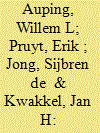

|
|
|
|
|
| Summary/Abstract |
While the shale revolution was largely a US’ affair, it affects the global energy system. In this paper, we look at the effects of this spectacular increase in natural gas, and oil, extraction capacity can have on the mix of primary energy sources, on energy prices, and through that on internal political stability of rentier states. We use two exploratory simulation models to investigate the consequences of the combination of both complexity and uncertainty in relation to the global energy system and state stability. Our simulations show that shale developments could be seen as part of a long term hog-cycle, with a short term drop in oil prices if unconventional supply substitutes demand for oil. These lower oil prices may lead to instability in rentier states neighbouring the EU, especially when dependence on oil and gas income is high, youth bulges are present, or buffers like sovereign wealth funds are too limited to bridge the negative economic effects of temporary low oil prices.
|
|
|
|
|
|
|
|
|
|
|
|
|
|
|
|
| 20 |
ID:
163544


|
|
|
|
|
| Summary/Abstract |
Transportation is the largest contributor to greenhouse gas emissions in the energy sector, which, in turn, is the largest contributor in Brazil. The way different policies mitigate CO2 emissions in the short, medium, and long-term is an ongoing research topic. Four potential policies for light vehicle fleet are investigated: (i) energy efficiency; (ii) modal change and regulatory management; (iii) renovation of the fleet; and (iv) biofuel increase. A system dynamics model is developed to estimate the delay in fleet turnover and its CO2 emissions change during the 1980–2050 period. The results indicate a rebound effect in the long-term when an objective of renovating the fleet is realized. Only if more stringent terms are considered will this policy contribute to further mitigate CO2 emissions in the long run. Results also demonstrate a longer-term perspective to energy efficiency and modal change policies, indicating the need for mandatory CO2 emission targets, unseen in the country at the present time. A biofuel increase strategy provides CO2 reduction in the short-term, and it is advisable this strategy be adopted alongside the other ones.
|
|
|
|
|
|
|
|
|
|
|
|
|
|
|
|
|
|
|
|
|